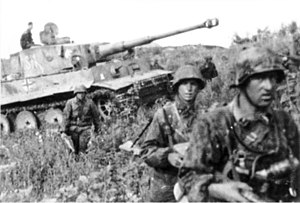Battle of Nagykanizsa: Difference between revisions
No edit summary |
No edit summary |
||
| Line 48: | Line 48: | ||
| casualties1 = {{Bulleted list|style=margin-left:-1em | | casualties1 = {{Bulleted list|style=margin-left:-1em | ||
|1= '''Total:'''{{plainlist| | |1= '''Total:'''{{plainlist| | ||
** | ** 168,792 men | ||
** | ** 1,203-1,410 tanks destroyed or damaged | ||
** | ** 653 aircraft}}}} | ||
| casualties2 = '''Total:'''{{plainlist| | | casualties2 = '''Total:'''{{plainlist| | ||
** 180,954 men | ** 180,954 men | ||
Revision as of 10:02, 6 April 2020
The Battle of Nagykanizsa was a Great War engagement between Granzerian and Vierz forces on the East Vierz Front near Nagykanizsa in Granzery between July and August 1947. The battle began with the launch of the Granzerian offensive Operation Hussar, on 5 July, with the aim of pinching the Vierz salient around Nagykanizsa with simultaneous armoured thrusts into the north and south of the salient. The Granzerian offensive achieved some initial success on the north salient while the southern offensive stalled. The Vierz forces launched powerful counterattacks on the north and south of the salient, involving armoured and mechanized forces which would cut off the Granzerian advance in the northern salient.
A week after the battle Tieradan and Vonzumieran forces on the Western Front began the Battle of Sejpedek and thus the invasion of Western Granzery, prompting Operation Hussar to be cancelled and troops to be withdrawn from the Vierz front to reinforce the collapsing front with Tierada. A month after the battle, Vierz troops were able to begin the Siege of Husegesvar which ended two months later with Granzery's unconditional surrender. The Battle of Nagykanizsa remains the largest battle fought on Granzerian soil and was one of the largest armoured battles of the Great War.
